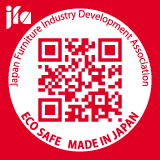The mark “Safe and Assured, Made in Japan” started!

The mark “Safe and Assured, Made in Japan” can be displayed by domestic furniture manufacturers that pay attention to “safety, assurance and environment,” which are main concerns of today’s customers.
The manufacturer that seeks to display this mark must comply with various standards: For example, the product must be made in Japan with the adequate evaluation of its strength and durability. The prevention of “sick-house syndrome” must also be considered, the materials must be procured from legal wood supply companies (whose goods are not logged illegally), and a warranty-repair service must be available so that the customer can use and enjoy the furniture for many years to come, etc.
What are the certification standards for “Made in Japan” furniture mark?
“Made in Japan” Furniture Standard:
The production process, including the manufacture of components of the furniture (excluding raw materials), must be accomplished in Japan.
Quality Standard:
- The furniture shall comply with the guidelines of JFA (Japan Furniture Industry Development Association), which has set the safety criteria based on the JIS (Japanese Industrial Standards).
- The safety handling instructions, including preparation against earthquakes, shall be described in the user manual.
Room Environment Standard:
The furniture shall comply with the Association’s “Guidelines on Sick-House Syndrome Prevention,” in which the use of raw materials with low formaldehyde emission is encouraged.
Wood Standard:
The wood used in such furniture shall be procured from legal wood supply companies (certified by the industrial association as having no involvement in illegal logging).
Protection Standard:
- The manufacturer shall be ready and able to respond to requests for maintenance and/or repair.
- The manufacturer shall carry product liability insurance in order to deal with any accident that might occur through the use of the furniture.
Ethical Standard:
The manufacturer shall not copy or use, without any prior written consent, the patents, utility models or designs of other companies or parties.

